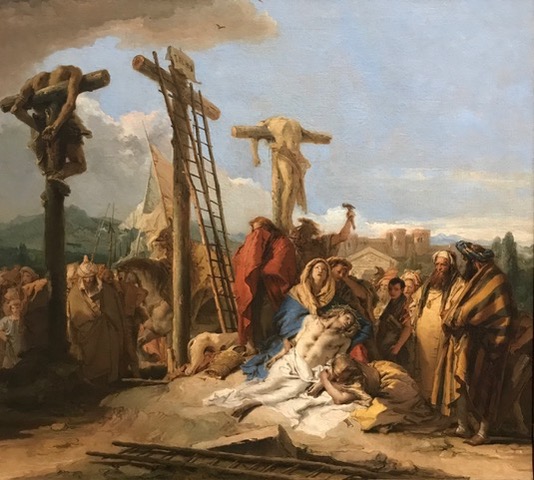Tiepolo Lamentation at the foot of the Cross 1750-60 National Gallery
This small painting in the National Gallery immediately caught my eye. As I approached it from a distance, I assumed that it was a painting of the crucifixion with Christ in the centre of the canvas, but soon realised that it was a painting of the deposition, with Christ’s body slumped on the ground being lamented by his mother and Mary Magdalene, while the two criminals are still on their crosses.
Mary looks heavenwards, as if berating God for what He has done; Mary Magdalene is passionately clasping Jesus’ arm, in a pose taken directly from Rembrandt’s sketch of the same subject. John has covered his face in his red cloak in a pose I hadn’t seen before, as if his world has come to an end and he cannot face the collapse of everything he believed in and hoped for. He just wants to hide from reality His highly expressive cloak dominates the centre of the canvas.
Christ’s body with the white shroud being drawn about him, lies limply, drained of blood and is the brightest element of the lower canvas. It is an ironic parallel to the paintings of the birth of Christ, where the baby is the source of light in the composition.
To the right stand Nicodemus and Joseph of Arimathea, looking wealthy and very well fed. Joseph will provide the tomb and the linen while Nicodemus, a popular pharisee who was also a thoughtful supporter of Jesus’ preaching, is about to supply sufficient myrrh and aloes for a royal burial.
Set harshly against the skyline is a raised claw hammer. Presumably the one that has just been used to remove the nails but held by a soldier as if to deliver a blow. It seems to indicate that the cruelty of the Roman army has not abated.
But none of this is exceptional. It was the criminals that really captured my attention. They are the key to the painting.
You can immediately tell which of the criminals railed at Jesus and which will be joining him in paradise: the clouds are the clue. Dark storm clouds are gathered around the shadowed form of the former, while the latter is bathed in light and surrounded by blue sky with a bird flying overhead. He has been crucified in the most agonising position, bent backwards over his cross, so that his head, which we cannot see, is fixed heavenwards.
I then realised why I had made my original mistake! The cross of the redeemed criminal is at the apex of a compositional pyramid. It starts with Mary Magdalene and the feet of Christ, rises to the hidden face of St John and continues upwards to the tortured body of the redeemed criminal bathed in light.
Tiepolo has given us something new and profound to consider. His lamentation of Christ carries as much depth of emotion as any painting of the deposition, but additionally he poses a challenging question: With the painting dominated by the two contrasting criminals in their tortured death throes, where do we see ourselves?
What choices are we making in our own lives that will result in us following the condemned criminal, or the redeemed one? It is a stark choice.

